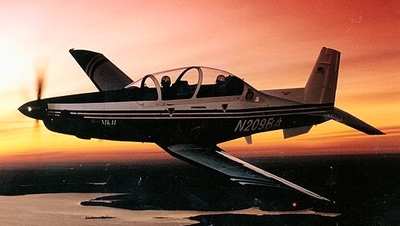Instructor Pilot and Student Reported Safe
A Navy T-6B Texan II trainer aircraft went down in a remote, unpopulated area of Alabama on Tuesday 17 January 2023. The aircraft’s two occupants, an instructor pilot and his student, ejected from the aircraft and were evaluated for reportedly minor injuries.

The accident involved a T-6B Texan II assigned to Training Air Wing 5 at Naval Air Station Whiting Field. The aircraft departed the northeast Florida facility without incident and proceeded some sixty-miles before the two pilots—for reasons yet unknown—ejected at approximately 10:50 EST in the vicinity of Barin Naval Outlying Field near the town of Foley in Alabama’s southern panhandle.
In an email statement, U.S. Navy spokesman Lieutenant John Lobkowicz set forth: "The aircrew successfully ejected from the aircraft and are in the process of receiving medical attention. No significant injuries have been reported at this time."
The accident remains under investigation.
The T-6B Texan II is used for primary U.S. Naval and Marine Corps flight training. The current version of the aircraft entered service with the U.S. Navy in 2010 and represents a departure from the decades-old training aircraft to which U.S. military student aviators and their instructors are typically relegated. Textron Aviation—Beechcraft’s parent company—has produced upwards of one-thousand T-6 Texan IIs for 13 nations and two North Atlantic Treaty Organization (NATO) flight schools.
Nearly all of the Navy’s 245 Texan IIs are split between Naval Air Station Whiting Field, Florida and Naval Air Station Corpus Christi, Texas.
Based on Pilatus’s PC-9, the T-6 Texan II is a low-wing cantilever monoplane with enclosed tandem seating for two and a retractable tricycle undercarriage. The aircraft is powered by single 1,100-shaft-horsepower Pratt & Whitney PT6A-68 turboprop engine in tractor configuration with a 97-inch (2.5-meter), aluminum, four-blade, constant-speed, variable pitch, non-reversing, feathering propeller assembly. The Texan II is fitted with Martin-Baker Mark 16 ejection seats and a canopy fracturing system.
The Texan II is a robust and speedy machine, eminently suited to military flight training. The airplane boasts a cruise speed of 280-knots, a Vne of 316-knots, a service-ceiling of FL310, a 900-nautical-mile range, and G-limits of +7.0 and -3.5.
Broadly speaking, the T-6 Texan II’s safety record is admirable. In 2019, a Texan II assigned to Sheppard AFB in Texas went down with both pilots ejecting safely. However, in October 2020, U.S. Navy Lieutenant Rhiannon Ross, a 30-year-old instructor pilot, and U.S. Coast Guard Ensign Morgan Garrett, a 24-year-old student pilot lost their lives when their T-6 went down in a residential area near Foley, Alabama, setting a house and several automobiles on fire.

The U.S. Navy, in 2022, suffered 17 Class-A manned aviation mishaps—incidents in which life is lost or damages equal $2.5-million or more. The figure represents a significant rise from the ten Class-A mishaps the service incurred in 2021 and continues a worrying trend that dates back to 2013.
Between 2013 and 2018, across the Navy’s entire aviation fleet, mishaps jumped by 82-percent. The protracted upswing in all mishaps (Class A, B, and C) has been attributed to myriad root causes, principal among which are automatic budget caps known as sequestration which took effect in 2013.
To meet the new budget caps, Navy brass cut depot work and purchases of spare parts. The service also cut loose large numbers of experienced mid-grade maintainers and their supervisors—losses that left fewer chief and senior chief petty officers on Navy flight lines as the depth of experience among newer E-4s and E-5s dropped.
Whether or not the 17 January 2023 Texan II crash is attributable to aircraft malfunction remains to be seen. What can be stated with certainty and gratitude, however, is that the crew has lived to fly another day.
 ANN's Daily Aero-Term (05.02.24): Touchdown Zone Lighting
ANN's Daily Aero-Term (05.02.24): Touchdown Zone Lighting Aero-News: Quote of the Day (05.02.24)
Aero-News: Quote of the Day (05.02.24) Aero-News: Quote of the Day (05.03.24)
Aero-News: Quote of the Day (05.03.24) ANN's Daily Aero-Term (05.03.24): UAS Traffic Management (UTM)
ANN's Daily Aero-Term (05.03.24): UAS Traffic Management (UTM) ANN's Daily Aero-Linx (05.03.24)
ANN's Daily Aero-Linx (05.03.24)




